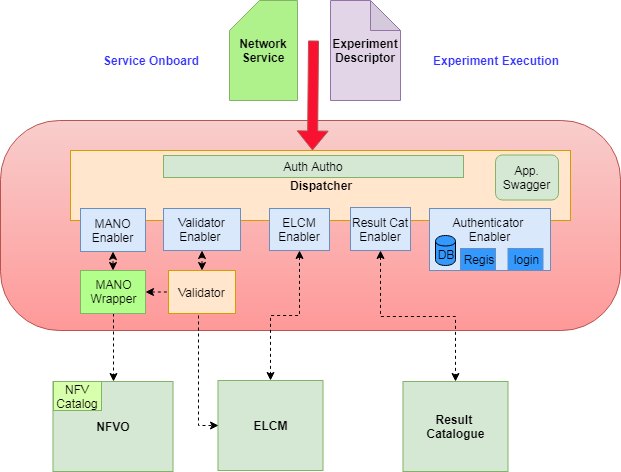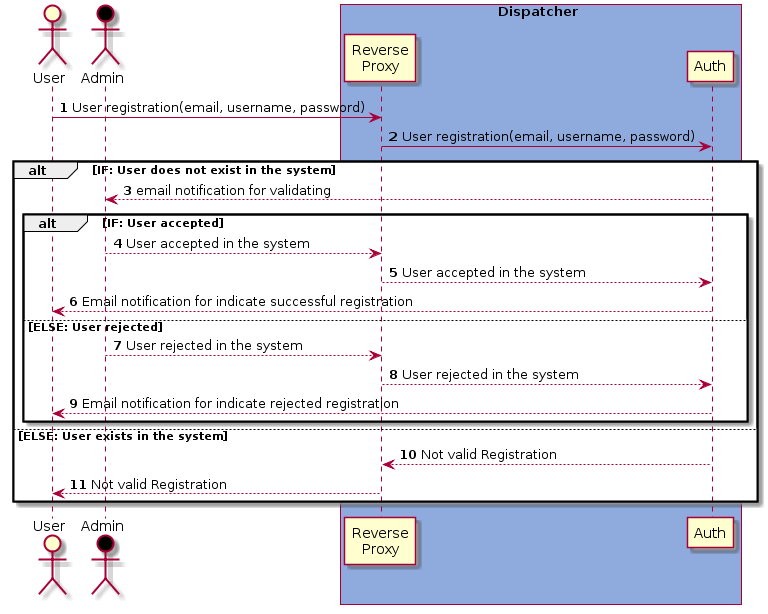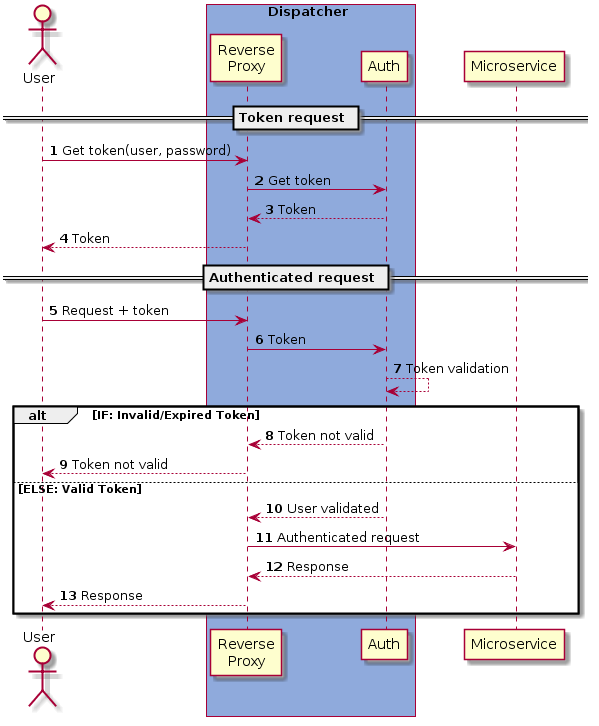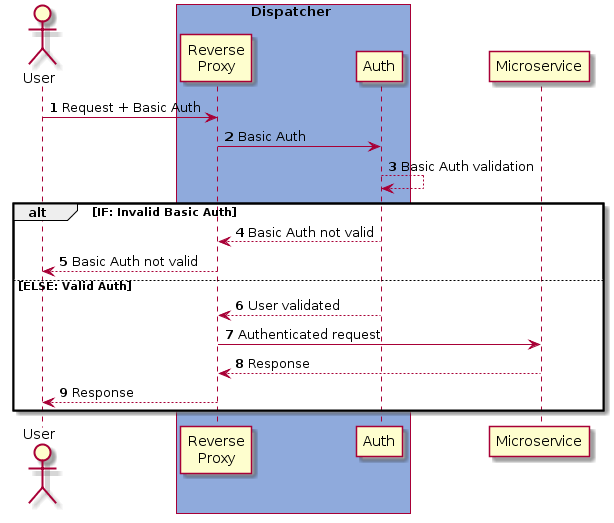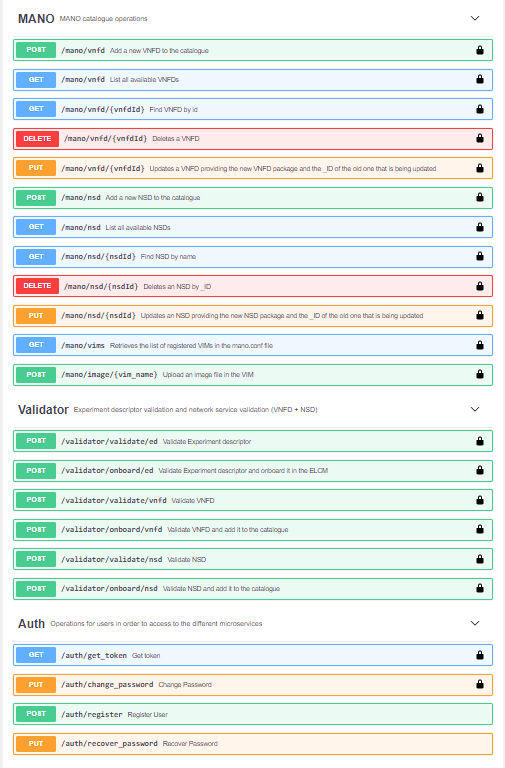The 5GENESIS Dispatcher is the entry point to the system, offering the functionalities to an Experimenter through a single interface. These functionalites are know as the Open APIs, being able to interact with the key features of the underlying modules (as shown in the architecture diagram below) without actually exposing them
This implementation is based on a NGINX reverse proxy containerised in a Docker environment.
By default, The Dispatcher includes as added on modules, the Validator, the MANO Wrapper and a Swagger environment to test the available features. On top of all that and to secure all the requests, the Dispatcher provides user registration and authentication using JWT. Consult the Auth documentation for the available actions and how to use them.
NOTE: As shown below in the architecture diagram, the Dispatcher does not deal with the MANO directly but through a wrapper that simplies the communication. Also for simplification, in this document we will refer to the MANO Wrapper as mano, which is conceptually correct from the Dispatcher point of view.
The available features will depend on the features exposed by each dispatched module. The currently available features are:
- Onboard VNFD
- List VNFDs
- Retrieve single VNFD
- Delete VNFD
- Update VNFD
- Onboard NSD
- List NSDs
- Retrieve single NSD
- Delete NSD
- Update NSD
- Retrieve registered VIMs
- Upload VIM images
- Launch experiment (create)
- Cancel execution
- Get execution logs
- Validation service: Validate Experiment descriptor, VNFD or NSD as a standalone service
- Retrieve stored experiments from the database
- Validate and onboard directly the Experiment descriptor in the ELCM, and the VNF descriptor or the NS descriptor in the NFVO
It is important to know how the application works to make the most of it knowing why every step is taken.
Authentication is delegated to the Auth module. Users are registered into it and provide the ability to an user to claim an access token. This token is a JSON Web Token. It contains user's identity (subject id, name, email) and some meta data relatives to the authorization process (issuer, time to live, etc.). The access token can be claimed using Basic Authentication (username + password). The access token is online, that is, a token used by client apps having a direct user interaction (GUI such as: web site, desktop apps, mobile apps, etc). It's a short-lived token, so it shall be renew before its expiration date using a refresh token. Once claimed, the access token is renewed as well as the refresh token. And the process is repeated during the whole user session life time. Instead of requesting an access token, it is also possible to authenticate every request using Basic Auth with a user already registered and validated by the Platform Administrator.
The user that wants to have access to the platform services will have to request the Platform Administrator for permission and the Administrator will grant it or deny it.
The Dispatcher allows two different authentication methods: Token authentication (JWT) and Basic authentication.
Prior to any request to a service, the user needs to obtain an authentication token using valid credentials and Basic Auth. Once received the token, this is valid for the next 5 minutes and can be used to query any service behind the Dispatcher.
Basic authentication is also available: A registered user, using valid credentials should use them in every query to a service behind the Dispatcher.
NOTE: To know more about the Auth module, go here
These instructions will get you a copy of the project up and running on your local machine for development and testing purposes after you clone the repository.
For running the 5Genesis Dispatcher, you will need:
- docker version >= 18.09.6
- docker-compose version >= 1.17.1
- Configuration files correctly filled up:
- Validator module config: Environment variables file (
config.env) inside the validator folder - MANO Wrapper module config: configuration file (
mano.conf) inside the mano folder
- Validator module config: Environment variables file (
- NFVO + VIM
The Dispatcher needs to be configured properly before the containers are built. For that, a simplified configuration file is offered: dispatcher.conf, which will have to be edited and adapted.
The file should contain information of all the modules the Dispatcher forwards information to (validator, mano, elcm, result_catalog, etc.) and how to do it. For each module, a new enabler will be added in the Dispatcher. It uses the following format:
[module_name]
PROTOCOL=[http|https]
HOST=x.x.x.x -> IP or DNS name of the host component
PORT=xxxx -> Port where the app API is available
PATH=/ -> Base path of the application ("/" by default)
[validator]
PROTOCOL=http
HOST=validator
PORT=5100
PATH=/
[mano]
PROTOCOL=http
HOST=mano
PORT=5001
PATH=/
The config file template already includes the validator and the mano modules as they are included within the Dispatcher. They are already configured and should not be touched.
During the installation process you will be asked for a couple of simple questions: One of them is whether you want the Authentication module installed as well or not, so it is completely optional.
Once edited properly, the configuration will be applied and the containers built, based on the config file we have just created (dispatcher.conf):
$ ./install.sh
[validator]
PROTOCOL=http
HOST=validator
port=5100
path=/
[mano]
PROTOCOL=http
HOST=mano
PROTOCOL=5001
PATH=/
[elcm]
PROTOCOL=http
HOST=192.168.33.102
PORT=5000
PATH=/api
With the sample config file above, using the ELCM API as an example, the dispatcher will translate the original request to a new one. For example, the original URL would be the following one:
Original URL: http://192.168.33.102:5000/api/v0/run
The previous URL is translated to a new one, removing the speficied base path (/api, in this example), adding a new base path common to all the requests directed to the ELCM (/elcm in this example) and leaving the particular endpoint (/v0/run) as it was:
Translated URL: http://{dispatcher_ip}:{dispatcher:port}/elcm/v0/run
The start script will deploy and run the Dispatcher container, the Validator, the MANO Wrapper and a Swagger environment to test the available features:
$ ./start.sh
Dispatcher will be accessible through port 8082.
Swagger environment will be accessible through port 5002.
To stop the Dispatcher service just run the following:
$ ./stop.sh
A swagger testing framework is deployed on port 5002 with the following API specifications:
Dispatcher logs containing all access attemtps to the application are available in the log folder of the application.
In case of needing any help, contact the authors for support.
192.168.33.11 - - [02/Jan/2020:15:31:05 +0000] 401 "POST /validator/validate/ed HTTP/1.1" 179 "-" "curl/7.59.0" "-"
192.168.33.11 - - [02/Jan/2020:15:31:44 +0000] 200 "OPTIONS /auth/get_token HTTP/1.1" 0 "-" "Mozilla/5.0 (Windows NT 10.0; Win64; x64) AppleWebKit/537.36 (KHTML, like Gecko) Chrome/79.0.3945.88 Safari/537.36" "-"
192.168.33.11 - - [02/Jan/2020:15:33:51 +0000] 204 "OPTIONS /mano/vnfd HTTP/1.1" 0 "-" "Mozilla/5.0 (Windows NT 10.0; Win64; x64) AppleWebKit/537.36 (KHTML, like Gecko) Chrome/79.0.3945.88 Safari/537.36" "-"
192.168.33.11 - Javier [02/Jan/2020:16:00:24 +0000] 200 "GET /auth/get_token HTTP/1.1" 363 "-" "PostmanRuntime/7.21.0" "-"
192.168.33.11 - - [02/Jan/2020:16:02:10 +0000] 200 "GET /mano/vnfd HTTP/1.1" 9407 "-" "PostmanRuntime/7.21.0" "-"
192.168.33.11 - - [02/Jan/2020:16:08:22 +0000] 401 "GET /mano/nsd HTTP/1.1" 179 "-" "PostmanRuntime/7.21.0" "-"
192.168.33.11 - Javier [02/Jan/2020:16:08:30 +0000] 200 "GET /auth/get_token HTTP/1.1" 363 "-" "PostmanRuntime/7.21.0" "-"
192.168.33.11 - - [02/Jan/2020:16:08:48 +0000] 200 "GET /mano/nsd HTTP/1.1" 4916 "-" "PostmanRuntime/7.21.0" "-"
- 2.3.2 - Fix Auth typos
- 2.3.1 - Improve Auth response messages
- 2.3.0 - Update validator component to store the experiments
- 2.2.0 - Update MANO component to provide list of registered VIMs
- 2.1.0 - Make Authentication optional during the installation process
- 2.0.1 - Auth module documentation updated
- 2.0.0 - User registration and authentication
- 1.3.3 - Added VNFD and NSD update to the MANO API features and image uploading.
- 1.2.3 - Move to fastjsonschema for draft 7 schema validation.
- 1.2.0 - MANO wrapper is included now inside the Dispatcher as a new container.
- 1.1.0 - Added logging in the Dispatcher and the Validator.
- 1.0.0 - First stable version including all features.
- Add cross-platform features.
Javier Melian (javier.melian@atos.net)
Licensed under the Apache License, Version 2.0 (the "License"); you may not use this file except in compliance with the License. You may obtain a copy of the License at
Unless required by applicable law or agreed to in writing, software distributed under the License is distributed on an "AS IS" BASIS, WITHOUT WARRANTIES OR CONDITIONS OF ANY KIND, either express or implied. See the License for the specific language governing permissions and limitations under the License.
